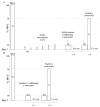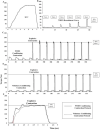Effects of NMES-elicited versus voluntary low-level conditioning contractions on explosive knee extensions
- PMID: 36458384
- PMCID: PMC9716298
Effects of NMES-elicited versus voluntary low-level conditioning contractions on explosive knee extensions
Abstract
Objectives: Electrically-induced or voluntary conditioning-contractions (CC) can be used to affect contractile properties of a subsequent explosive contraction (EC). Here, we aimed at comparing the effect of neuromuscular-electrical-stimulation (NMES) vs voluntary CC performed prior to explosive contractions of the knee extensors.
Methods: A 10 sec NMES CC (100Hz, 1000μs, 10% MVC), or a voluntary contraction (VOL CC) mimicking the NMES CC, preceded an isometric EC of the knee extensors. Explosive contraction was performed with the goal to reach the target (70% MVC) as quickly as possible.
Results: All the parameters related with the explosive contractions' muscle-output were similar between protocols (difference ranging from 0.23%, Mean Torque; to 5.8%, Time to Target), except for the Time to Peak Torque, which was lower when preceded by NMES (11.1%, p=0.019). Interestingly, the RTD 0-50 ms_EC was 37.3% higher after the NMES compared with the VOL CC protocol.
Conclusion: Explosive contraction was potentiated by an NMES CC as compared with a voluntary CC. This may be due to a reduction in descending drive following VOL CC, which has been shown to occur even with low-level voluntary efforts. These findings could be used to improve rehabilitation or training protocols that include conditioning contractions.
Keywords: Afferent pathways; Electrical Stimulation; Explosive contraction; Rate of Torque development.
Conflict of interest statement
The authors have no conflict of interest.
Figures


Similar articles
-
Potentiation of maximal voluntary concentric torque in human quadriceps femoris.Med Sci Sports Exerc. 2012 Sep;44(9):1738-46. doi: 10.1249/MSS.0b013e318256b813. Med Sci Sports Exerc. 2012. PMID: 22460473
-
Twitch potentiation after voluntary contraction and neuromuscular electrical stimulation at various frequencies in human quadriceps femoris.Muscle Nerve. 2012 Jan;45(1):110-5. doi: 10.1002/mus.22259. Muscle Nerve. 2012. PMID: 22190316
-
Modulation of spinal excitability following neuromuscular electrical stimulation superimposed to voluntary contraction.Eur J Appl Physiol. 2020 Sep;120(9):2105-2113. doi: 10.1007/s00421-020-04430-5. Epub 2020 Jul 17. Eur J Appl Physiol. 2020. PMID: 32676751 Free PMC article.
-
Effects of Neuromuscular Electrical Stimulation and Resistance Training on Knee Extensor/Flexor Muscles.Coll Antropol. 2015 Jul;39 Suppl 1:153-7. Coll Antropol. 2015. PMID: 26434024 Clinical Trial.
-
Contraction type influences the human ability to use the available torque capacity of skeletal muscle during explosive efforts.Proc Biol Sci. 2012 Jun 7;279(1736):2106-15. doi: 10.1098/rspb.2011.2109. Epub 2012 Jan 18. Proc Biol Sci. 2012. PMID: 22258636 Free PMC article.
References
-
- Bishop D. Warm up I. Sports medicine. 2003;33(6):439–454. - PubMed
-
- Baudry S, Duchateau J. Postactivation potentiation in human muscle is not related to the type of maximal conditioning contraction. Muscle Nerve. 2004;30(3):328–36. - PubMed
-
- Vandervoort A, Quinlan J, McComas A. Twitch potentiation after voluntary contraction. Experimental Neurology. 1983;81(1):141–152. - PubMed
-
- Smith CB, Allen MD, Rice CL. Voluntary rate of torque development is impaired after a voluntary versus tetanic conditioning contraction. Muscle Nerve. 2014;49(2):218–24. - PubMed
